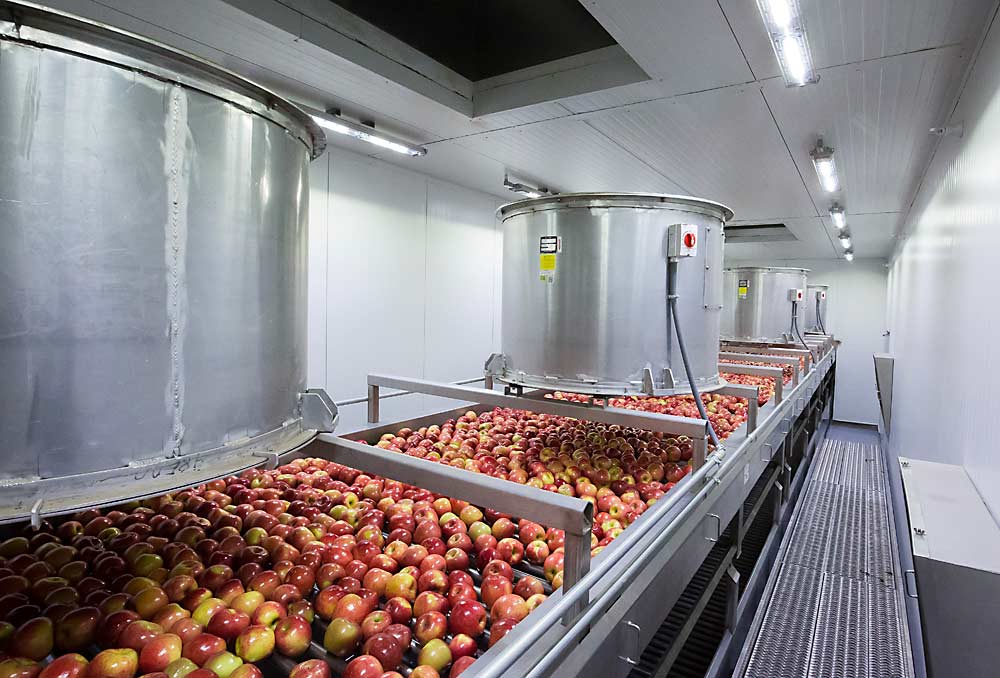Packing facilities are constantly upgrading with new equipment and technology.
Optical sorters. Robotic palletizers. Smart baggers. The list goes on.
Good Fruit Grower has put together this look at a few highlights around the industry, as seen on industry tours throughout 2018.
Kershaw Fruit and Cold Storage
Kershaw Fruit and Cold Storage in Yakima, Washington, turned to an old and simple form of technology to combat the modern and serious threat of listeria after the outbreak linked to contaminated apples at Bidart Bros. in California: bubblers.
The company simply piped air into the water of the flume tank to create turbulence. As the apples float over the bubbles, they tilt and roll, exposing the calyxes and stems to the sanitation solution.

“These are like an old-school thing that everyone used to use for years and then they just kind of went away,” said Aaron Arndt, production and operations manager at Kershaw Fruit, during an industry tour in March 2018.
Without the rapids, the apples would float stem-up or calyx-up, leaving two contaminant-prone points untouched in the sanitation process.
Kershaw installed its new line in 2012. In 2014-15, a listeria outbreak that sent 34 people to the hospital was traced to the Bidart Bros. packing line.
In reaction, Kershaw managers began looking for ways to add turbulence to the line. A few of the veteran mechanics and managers told Arndt packing lines commonly used bubblers in the 1990s to create more momentum. Arndt and his crews tinkered for a few months and welded their final version, a 1.5 horsepower blower with stainless steel pipes, into place in 2016.
The upgrade cost less than $1,500, Arndt estimated.
Another benefit surprised the company after the addition. The bubbles actually boosted the efficiency of their line by giving the fruit a little momentum to help it through some upcoming 90-degree turns, which was the whole point of the bubblers back in the day.
Washington Fruit and Produce
Robotic pallet stackers aren’t exactly brand new, but not all places have them yet, said Mikey Hanks, a system operator at Washington Fruit and Produce Co. in Yakima.
The company installed its robotic arms in 2010 and now has 10 cells — or spots — with robotic packing, he said.
“Everyone wants them, but not everyone has them,” he said.
Today, the robots stack 70 to 80 percent of the boxes on pallets, leaving the few workers in the segregating room with little hand labor. The machinery packs, on a busy day, 20,000 boxes per 10-hour shift.
They also line up boxes perfectly, 8 feet tall, giving the stack a sturdier structure with less bruising to the apples than when stacking by hand. That’s true regardless of box size or style, something a conventional palletizer could not do, he said.
However, nothing is perfect. Even robots get slightly off track and knock over a few boxes from time to time, Hanks said. It’s rare, but it happens.
Columbia Fruit Packers
A remodel at Columbia Fruit Packers’ warehouse in East Wenatchee, Washington, included a self-contained drying tunnel tall enough for workers to walk into and clean efficiently.
Plant manager Jack Crowe gave a tour of the new line, along with Josh Heinicke, assistant plant manager.

Kept at a steady 120 degrees Fahrenheit, with regulated humidity, the room includes two natural gas-fed burners and one output fan. Fruit moves at chest-level on metal rollers, but the fruit doesn’t actually roll so it doesn’t bruise, Heinicke said.
Workers can use brushes to clean the rollers, which doesn’t take long, and because components such as electrical wiring are on the outside walls of the tunnel, cleaning the notoriously difficult-to-clean drying area has become more efficient, he said.
“The structure of the tunnel is on the outside, so we have nothing but clean walls inside,” he said. “From a food safety perspective, that’s great.” •
—by Ross Courtney and Shannon Dininny
Correction: This story incorrectly used the term “turbidity” in our January 15, 2019, print issue. The correct term, turbulence, has been included online. Good Fruit Grower regrets the error.






Leave A Comment